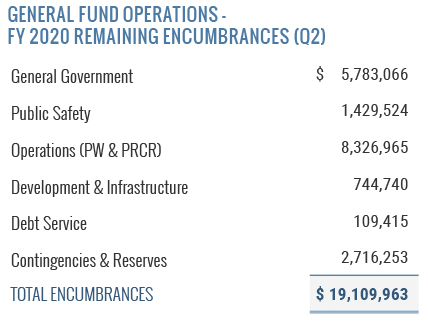General Fund
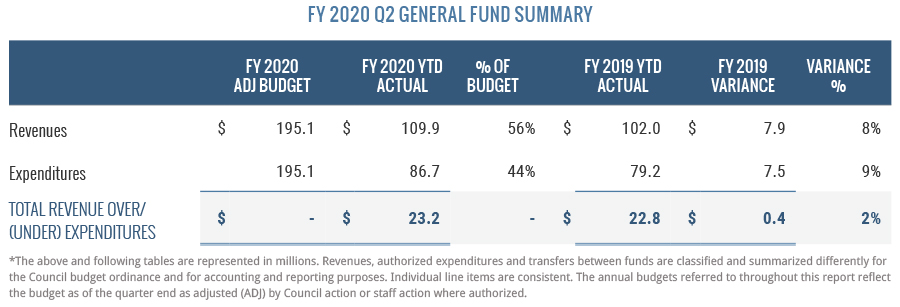
Overall net results for Q2 are relatively consistent with the prior year’s second quarter, improving by two percent. Both revenues and expenditures have increased by less than 10 percent, and details on notable revenues and expenditures by
category follow.
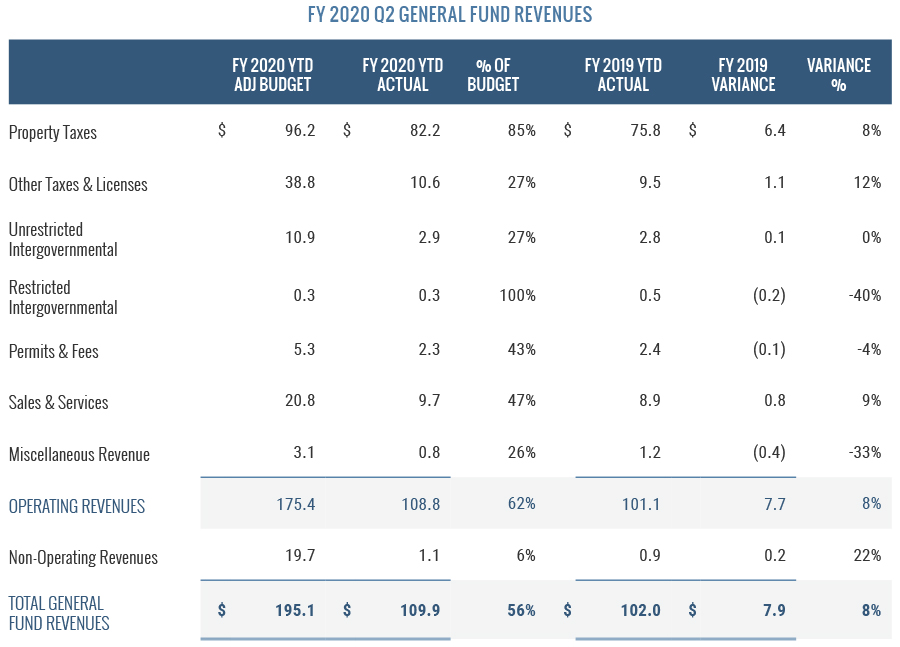
Overall, General Fund revenues have increased eight percent compared to the prior year.
Property Tax
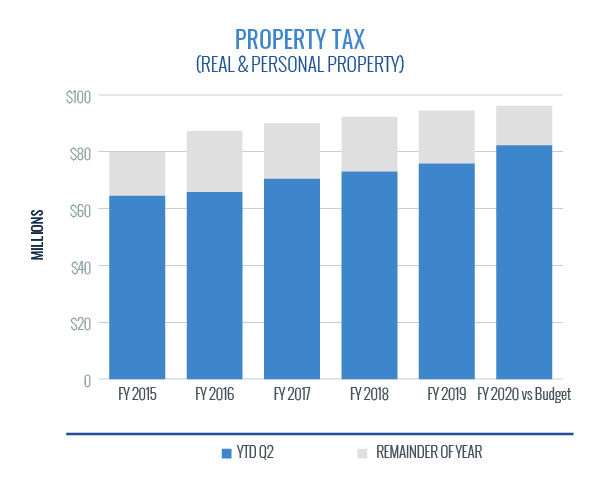
Property tax revenue is 54 percent of total budgeted operating revenues and is the largest single revenue source for the General Fund. Taxes are based on an ad valorem tax levy on real property and personal property. Real property includes land and buildings, and personal property primarily includes vehicles and commercial business equipment. Real property taxes were billed in July 2019 and were due no later than January 6, 2020. Most real property tax revenue is received during Q2. Conversely, most personal property tax revenue is collected throughout the year based on the State of North Carolina’s Tax and Tag program, which combines the vehicle ad valorem tax collection with the State’s vehicle license renewal process.
The FY 2020 budget for real property tax is $90.1 million. As of Q2, Cary has received $79.0 million, or 88 percent of the real property tax budget. Collections increased eight percent compared to the same period in FY 2019. The FY 2020 budget for personal property tax is $6.1 million. As of Q2, Cary has received $3.2 million or 53 percent of the personal property tax budget, a 17 percent increase from FY 2019. Property tax collections are sensitive to how the holidays fall near calendar year end, so the property tax collection increase compared to FY 2019 cannot yet be projected through fiscal year end. At a minimum, both real and personal property tax revenues are expected to meet budget which is three percent greater than the prior year budget.
Sales Tax
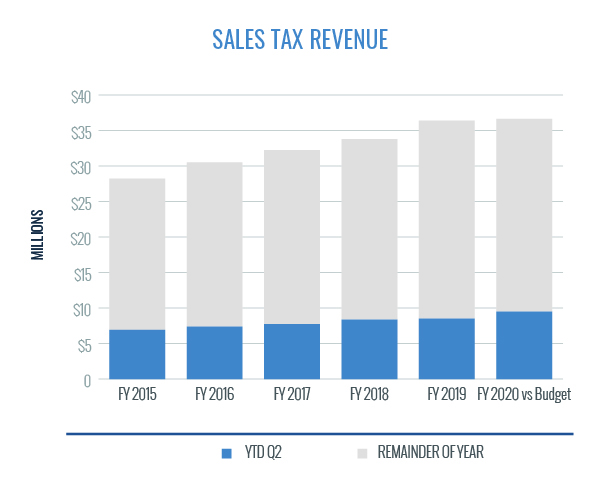
Sales tax makes up 21 percent of budgeted General Fund operating revenue and is a component of the category of Other Taxes & Licenses. Revenue in this category increased by 12 percent, or $1.1 million, compared to the same time last year. Sales tax increases account for $950,000 of the $1.1 million change. This revenue stream is distributed to municipalities by the NC Department of Revenue approximately two and a half months after the month when taxable sales occurred. Through Q2, Cary has received three distributions for July through September sales. As of Q2, Cary has received $9.5 million in sales tax revenue, an 11 percent increase over the same time period in FY 2019. This increase is directly linked to the strong economy. In the prior two years at the end of Q2, sales tax revenue has represented approximately 24 percent of the total actual revenues. Actual Q2 sales tax revenues are consistent with past years’ results, representing receipts at 26 percent of the budget.
Intergovernmental Revenue
Intergovernmental revenue makes up six percent of total budgeted General Fund revenues. Sales taxes on electricity, natural gas and wireless communications comprise 91 percent of the budgeted revenue sources in this category. Utilities sales taxes are budgeted at $10.2 million in FY 2020. The state distributes utility sales tax revenue in December, March, June and September. Cary received $2.9 million during Q2, one percent more than the same distribution in FY 2019.
Revenues in the Restricted Intergovernmental category decreased 40 percent in Q2 FY 2020 compared to the same period in FY 2019. This decrease reflects a smaller allocation of Federal Forfeiture funds for the Police Department — $100,000 in FY 2020 compared to $300,000 in FY 2019.
Sales and Service
The increase in Sales and Service revenue is primarily the result of the sanitation fee increase of $2.50 per month to help address recycling costs, which continue to increase. This increase is reflected in the FY 2020 budget.
Other Revenue
Miscellaneous revenue declined 33 percent due to a difference in the timing of billing to NCDOT for traffic signal maintenance.
Non-operating revenues increased 22 percent in FY 2020 compared to FY 2019, due to an increase in bond proceeds and investment earnings.
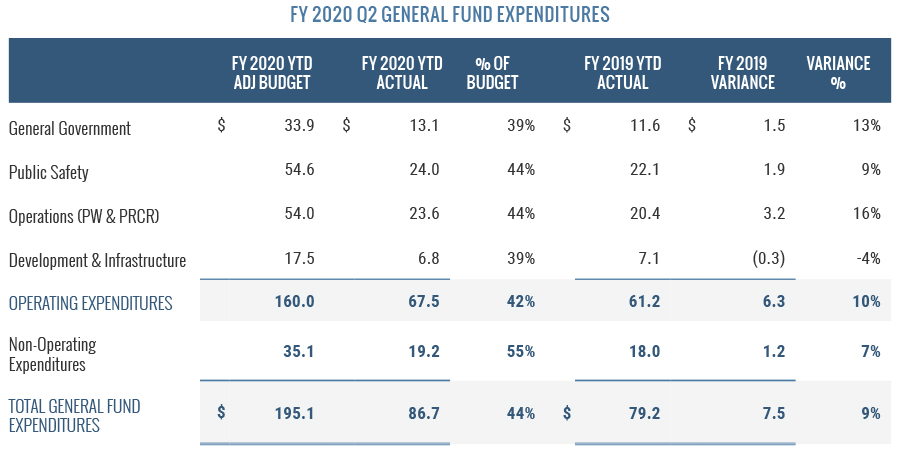
The 10 percent increase in operating expenditures reflects the timing of payments for technology and license agreements, the timing of payments for small projects across town facilities and expected increases in recycling expenditures. Additionally, the salaries and benefits for 12 firefighters hired in the second half of FY 2019 impacted this variance.
Encumbrances represent funds that have been reserved to satisfy a commitment to make a purchase. The table to the right shows the total outstanding encumbrances at the end of Q2. Considering these encumbrance amounts along with year-to-date spending amounts, the General Fund has over $89 million available in the operating budget to cover expenditures for the remainder of the fiscal year.
